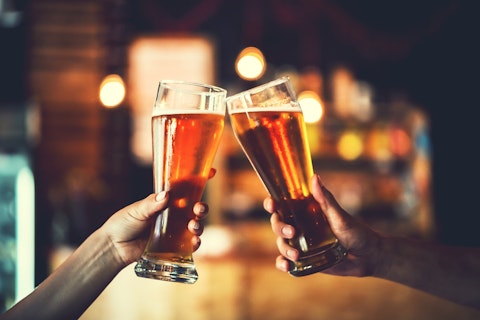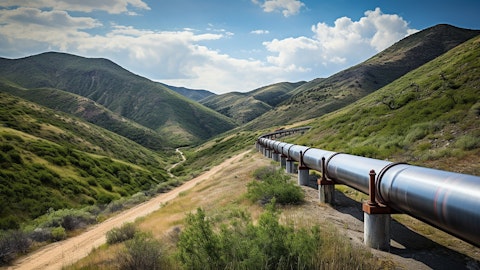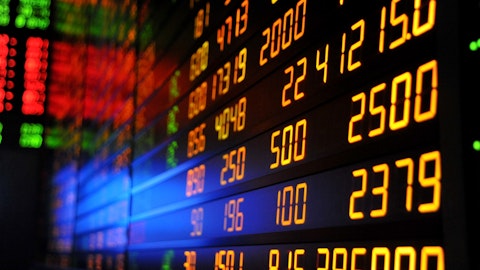In this article, we are going to discuss the 20 states with the highest alcohol and beer tax. You can skip our detailed analysis of the importance of the U.S. alcohol industry, the impact of Covid-19 on alcohol consumption in America, the effect of taxes on alcohol abuse, and the call for lower tax rates for canned cocktails, and go directly to 5 States with the Highest Alcohol and Beer Tax.
Federal taxation of alcohol dates back to the earliest years of the republic. In 1791, almost immediately after the Constitution was ratified, Alexander Hamilton pushed for a national excise tax on liquor as a means of raising revenue to pay down the national debt. The Founding Father believed that a tax on distilled spirits would be useful both because they were widely consumed, and thus represented a fairly large tax base, but also because he perceived distilled spirits to be a luxury good, and thus a tax might be fairly progressive.
Many social reformers also believed distilled spirits were damaging to society, and so looked favorably on higher taxes. These arguments for excise taxes, that they tax socially damaging goods, or luxury goods, or serve as advantageous and politically popular revenue sources, continue even today in various forms.
The Importance of the U.S. Alcohol Industry:
As we mentioned in our article – US Alcohol Exports by Country: Top 15 – booze plays an enormous role in the American economy. As of 2021, the total share of the beverage alcohol market in the U.S. represented almost $250 billion and over 3.4 billion cases sold. Beer/FMB/hard seltzer accounted for 43.5% of value share, followed closely by spirits at 39.5%, and wine at a 17% share.
The U.S. alcohol beverage industry is responsible for sustaining more than 4 million jobs and generating almost $70 billion in annual tax revenue. And that doesn’t even scratch the surface of the economic benefits the industry provides to late night restaurants and pizza shops. Per the Beer Institute, the beer industry alone supports 1.75 million jobs. From the farmers harvesting the barley in your beer, to the beer truck driver, to your local bartender, every aspect of your drink exists because of someone in the alcohol industry working hard behind the scenes.
The positive economic impact of alcohol is something you seldom consider when having a drink, but, given the facts, maybe it’s time we all raise a glass to it.
The Impact of Covid-19
As the Covid-19 virus tightened its grip on the country in 2020, the hospitality industry took one of the biggest economic hits, but that didn’t mean it became harder to get a drink. With almost every state relaxing its alcohol laws in 2020 in an effort to keep local economies afloat, it was even easier to kick back with a drink after a bad day. All but three states gave liquor stores a lockdown exemption, with many classifying the business – along with grocery stores and pharmacies – as an essential service.
In the first few weeks of the lockdown, alcohol sales for off-premise locations jumped 54% and online alcohol sales had increased by 262% compared to sales data from the same week in 2019. From March to September 2020, there were $41.9 billion in liquor store sales, representing an increase of 20% from the same period the previous year.
Americans drank more alcohol during the pandemic and this was also reflected in the resultant imposts collected by the national kitty. Alcohol tax revenues collected by the U.S. Treasury Department rose by 8% in the fiscal year that ended on Sept. 30, 2021, compared to the previous year, and remained well above pre-pandemic levels.
The Effect of Taxes on Alcohol Abuse:
The booze industry argues that alcohol excise taxes do not reduce heavy drinking because of substitutions to lower-cost products and that these taxes disproportionately burden low-income drinkers. Alternatively, over the last two decades, a growing number of economists have examined the impact of alcohol beverage taxes and prices on alcohol consumption and heavy drinking. Several of these studies have focused on high-risk populations, such as youth and young adults, including college students.
This research, using a variety of different data and empirical approaches, has generally found that an increase in the prices of alcoholic beverages led to reductions in drinking, heavy drinking, and the consequences of alcohol use and abuse. These findings indicate that a rise in alcoholic-beverage taxes could be a highly effective option for reducing alcohol abuse and its consequences.
Increasing alcohol taxes could not only improve public health, but also reduce the disparity between alcohol-related costs and total alcohol taxes in states. It could help prevent the reallocation of the societal cost of drinking from those who drink excessively to the general public. Conversely, if specific excise taxes are not increased, these taxes are likely to further erode over time because of inflation, which could result in an even greater disparity between alcohol taxes and alcohol-attributable costs. Due to their higher levies on booze, several of the names in our list of States with the Highest Tax on Alcohol also rank among the States that Drink the Least Alcohol per Capita.
According to a study conducted by the NCD Advisory Council’s signature initiative working group, if countries of the WHO European Region were to introduce a minimum level of 15% tax on the retail price per unit of alcohol, regardless of the type of alcoholic beverage, it would save 133,000 lives each year.
Lower Tax Rates for Canned Cocktails:
The spirits industry has an effort underway to lobby states to lower taxes on canned cocktails to more closely mimic those placed on beer and hard seltzer. Since distilled spirits face the stiffest tax rates due to their high alcohol content, canned cocktails are also taxed heavily at every level. However, distillers argue that Ready-to-Drink cocktails have similar alcohol content as beer and hard seltzer and are treated unfairly just because their drinks contain spirits. In 2020, U.S. consumption of canned cocktails grew 52.7% from the previous year, accounting for 6.9% of the total volume in the alcoholic ready-to-drink category, according to IWSR data. The higher sales have encouraged liquor companies to take the offensive in a fight for tax parity.
As a result, several states have already taken steps to level the field in favor of the canned cocktails, and thus support the country’s burgeoning craft-distilling industry. An example of this is Michigan, where in 2021, Governor Gretchen Whitmer signed SB 144 – a bill to increase market access to RTD cocktails for adult consumers and reduce the tax on these spirits-based products. Under the new law, the tax rate on RTD cocktails up to 13.5% ABV has decreased from $0.48 to $0.30/liter.
Ready-to-drink beverages continue to make headlines as the fastest-growing alcohol beverage category. While malt-based RTDs still retain a 91% share by volume in the American RTD market, spirit-based RTDs grew by 51% in 2021, approximately double the growth of the wine-and malt-based categories. As we mentioned in our article – 25 Most Popular Spirits in the World – the spirits-based RTDs are expected to grow at a CAGR of 33% in volume in the U.S. by 2025.
A recent new spirit-based RTD offering that popped up in the market is the good ol’ Jack & Coke. Although the classic drink has been a quintessential serve at every bar for a long time, the much-loved cocktail is now also available in the form of a pre-mixed, canned RTD – courtesy of a joint venture between the Brown-Forman Corporation (NYSE:BF-B) and The Coca-Cola Company (NYSE:KO).
Jack Daniel’s and Coca-Cola RTD made its U.S. debut in March this year in 12-oz. cans (7% ABV), and Jack Daniel’s and Coca-Cola Zero Sugar also became available in May. Brown-Forman Corporation (NYSE:BF-B) and The Coca-Cola Company (NYSE:KO) took a test-and learn-approach for the initial launch, applying lessons from a single-country rollout in Mexico to a global scaling strategy, bringing the product to 13 countries in 12 months.
Both the Brown-Forman Corporation (NYSE:BF-B) and The Coca-Cola Company (NYSE:KO) rank among the Largest Beverage Companies in the World in 2023.
With that said, here are the States with the Highest Liquor and Beer Taxes.

Ievgenii Meyer/Shutterstock.com
Methodology:
To collect data for this article, we have referred to the Distilled Spirits Council of the United States, looking for States with the Highest Alcohol and Beer Tax in 2023. Since distilled spirits face the stiffest tax rates due to their high alcohol content, we have ranked the following states by their distilled spirits excise tax rates as of January 2023. To allow for comparability across states, DISCUS uses a methodology for estimating tax rates that accounts for the various ways in which spirits are taxed and sold. These figures include case and bottle fees, special sales taxes on spirits (separate from, and in addition to, the excise tax), wholesale taxes, and retail and distributor license fees. Moreover, we have also mentioned the beer excise tax rate for each state below.
20. Arkansas
Excise Tax Rate on Distilled Spirits: $8.01 per gallon
Excise Tax Rate on Beer: $0.35 per gallon
Arkansas laws are strict and uncompromising when it comes to liquor, and more than half of the state’s counties are dry. In these counties, there’s no legal sale of alcohol in bars or stores and only licensed restaurants can serve alcoholic beverages.
19. West Virginia
Excise Tax Rate on Distilled Spirits: $8.32 per gallon
Excise Tax Rate on Beer: $0.18 per gallon
‘The Mountain State’, with its less-restrictive alcohol laws, has over 28 breweries. Liquor was only sold in state-owned stores in West Virginia before 1990, after which the state auctioned off permits to private businesses to legally sell alcohol. However, due to the predominant religious sentiment in West Virginia and the state’s high alcohol tax rates, it still has a very low alcohol consumption rate compared to the rest of the country.
18. Vermont
Excise Tax Rate on Distilled Spirits: $8.39 per gallon
Excise Tax Rate on Beer: $0.27 per gallon
Last year, Vermont Gov. Phil Scott signed legislation lowering taxes on ready-to-drink spirits, the latest front in an ongoing battle within the alcoholic beverage industry that pits distillers against beer and wine makers across the country. The bill reduced taxes on packs of ready-to-drink spirits to $1.10 per gallon. However, beer and wine producers say the ready-to-drink cocktails deserve the higher tax rates and limited sales space because of the type of alcohol they deliver.
17. Mississippi
Excise Tax Rate on Distilled Spirits: $8.51 per gallon
Excise Tax Rate on Beer: $0.43 per gallon
According to Mississippi laws, the maximum alcohol content allowed in beers is 8% and beers with an alcohol content of over 8% are illegal. However, despite being a state with high excise tax on beer, Mississippi ranks among the U.S. States With the Highest Beer Consumption per Capita.
16. Illinois
Excise Tax Rate on Distilled Spirits: $8.55 per gallon
Excise Tax Rate on Beer: $0.23 per gallon
Of the $62.6 billion in taxes collected by Illinois in 2022, 0.5%, or $320 million, came from alcoholic beverages sales tax. Illinois is ranked 28th out of the 50 states in alcohol consumption, with the average drinking-age Illinoisan consuming 2.32 gallons per year.
15. Minnesota
Excise Tax Rate on Distilled Spirits: $8.7 per gallon
Excise Tax Rate on Beer: $0.47 per gallon
In 2013, The Minnesota House approved a bill that would raise state taxes by $2.6 billion, in part, by enacting the state’s first alcohol tax increase in about 25 years. With the exception of Iowa, Minnesota is the state with the highest alcohol tax rate between all of its neighbors.
14. Kentucky
Excise Tax Rate on Distilled Spirits: $9.25 per gallon
Excise Tax Rate on Beer: $0.93 per gallon
Although Kentucky is home to the country’s burgeoning Bourbon industry, the Bluegrass State has the 17th lowest share of adults who report excessive drinking at 17.3%, compared to 19% nationwide.
2021 was a great year for the state’s Bourbon industry and for the first time there were more than 10 million barrels of Bourbon aging across Kentucky, and distillers set records by filling nearly 2.5 million barrels in a single year. However, this also meant that distillers in Kentucky were slated to pay more than $33 million in aging barrel taxes in 2021 alone. That figure was 140% higher than it had been 10 years before.
13. Montana
Excise Tax Rate on Distilled Spirits: $10.57 per gallon
Excise Tax Rate on Beer: $0.47 per gallon
The distilleries of Montana create all sorts of high quality alcoholic spirits. From huckleberry gins to Montana moonshine to bacon-flavored vodka, there’s a liquor out there for everyone.
Since Montana does not levy a sales tax, it tends to have relatively lower tax rates on beer and wine, however, it still ranks among states with the highest liquor tax. The Treasure State has a liquor monopoly, which means that it sells alcoholic beverages at its own stores and adds a tax at the point of sale.
12. Ohio
Excise Tax Rate on Distilled Spirits: $11.38 per gallon
Excise Tax Rate on Beer: $0.18 per gallon
An uptick in alcohol consumption in the Buckeye State in 2020 meant more alcohol tax revenue. Ohio generated $113.6 million in taxes on alcohol sales in 2020 – an increase of 7.8% over 2019 and up 11% from 2018.
However, the average Ohioan drank 689 alcoholic drinks in 2021, an 11% decrease from 776 the previous year, according to a survey by DrugAbuse.com. A possible reason for this welcomed drop in drinking could be a change in routines for individuals, as restrictions eased in the pandemic’s second year and more people returned to out-of-home jobs.
Anheuser-Busch InBev SA/NV (NYSE:BUD) and the City of Columbus are launching the first ever city-wide program in the U.S. to understand and help reduce the harmful use of alcohol, as part of the beer giant’s Global Smart Drinking Goals initiative. As part of the initiative, Anheuser-Busch InBev SA/NV (NYSE:BUD) has committed to investing at least $1 billion across its markets in dedicated social marketing campaigns and programs to influence social norms and individual behaviors to reduce harmful use of alcohol. Anheuser-Busch InBev SA/NV (NYSE:BUD) ranks among the Largest Alcohol Companies in the World in 2023.
11. Maine
Excise Tax Rate on Distilled Spirits: $11.96 per gallon
Excise Tax Rate on Beer: $0.35 per gallon
Maine is a control state, meaning it manages the wholesale of spirits. However, the state’s grocery stores and gas stations are still allowed to sell beer, wine, and liquor. Though famous for its coffee flavored brandy, the Pine Tree State is home to over 90 breweries, with Portland as an important city in the American craft beer industry.
10. Idaho
Excise Tax Rate on Distilled Spirits: $12.15 per gallon
Excise Tax Rate on Beer: $0.15 per gallon
Although Idaho ranks among the Least Alcoholic States, Idahoans set a new record for the highest spending on liquor in the last financial year, which ended on June 30th 2023. The Gem State’s residents spend just under $320 million on liquor during the year, with the state, cities, and counties raking up $115.6 million in liquor tax revenue.
In Idaho, beer containing more than 4% ABV is considered ‘strong beer’ and is taxed like wine at $0.45 per gallon. Idaho is counted among the Top 10 States with the Highest Tax on Alcohol.
9. Alaska
Excise Tax Rate on Distilled Spirits: $12.8 per gallon
Excise Tax Rate on Beer: $1.07 per gallon
Alaska has a reputation as a hard-drinking state with simple tastes. However, the state’s alcohol preferences are changing and it’s drinking less beer, more liquor and more wine. It’s also drinking less mainstream beer and more craft beer.
When Alaska’s state alcohol tax was increased in 1983 and 2002, a study of 40 years’ worth of health outcomes data found significant and lasting reductions in the numbers and rates of deaths in Alaska caused by alcohol-related diseases.
Alaska sits among the states with the highest tax on beer.
8. Michigan
Excise Tax Rate on Distilled Spirits: $13.57 per gallon
Excise Tax Rate on Beer: $0.2 per gallon
According to a new Michigan law introduced last year, liquor taxes will now pay for the state’s deputy road patrol. It will add $15 million in its first year and an extra 5% in subsequent years to cover for inflation.
Gov. Gretchen Whitmer also signed legislation this summer that would allow for the sale of alcohol in college stadiums and arenas in the Great Lake State.
7. Iowa
Excise Tax Rate on Distilled Spirits: $14.1 per gallon
Excise Tax Rate on Beer: $0.19 per gallon
Aside from the effect of high taxes, alcohol is more on the expensive side in Iowa because of state laws that force brewers and distillers to use state required distribution partners, and state-run warehouses. Some of these laws are left over from prohibition while others are meant to protect local distributors from abuse from large brewers. The Hawkeye State collected a total of $168 million in taxes from liquor sales in FY 2021, putting it among the States with the Highest Alcohol Tax.
6. Utah
Excise Tax Rate on Distilled Spirits: $15.92 per gallon
Excise Tax Rate on Beer: $0.41 per gallon
Most people know Mormons are supposed to be teetotalers, so the fact that Utah doesn’t drink much isn’t surprising. Over half of the state’s population identifies as Mormon, a religion that explicitly forbids alcohol consumption. However, the Beehive State’s liquor and wine stores still witnessed alcohol sales of $557.6 million last year, bringing in $198.66 million in revenue to pay for statewide services like transportation and infrastructure, health, education, public safety, school lunches for kids, and underage drinking prevention.
Utah ranks 6th in our list of states with high alcohol tax.
Click to continue reading and see the 5 States with the Highest Alcohol and Beer Tax.
Suggested Articles:
- 30 Drunkest Countries in the World
- 30 Drunkest Cities in America in 2023
- 20 Best Low-Alcohol Beers in America
Disclosure: None. 20 States with the Highest Alcohol and Beer Tax is originally published on Insider Monkey.





